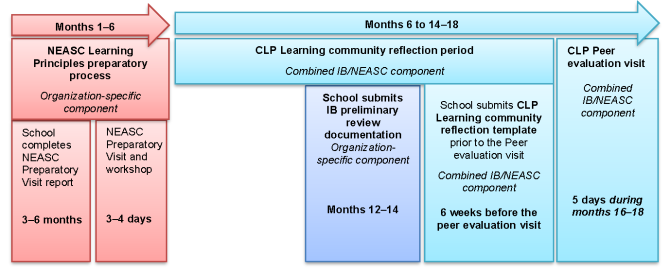
Pathways to Accreditation - International Education
Collaborative Learning Protocol - International Education
IB and NEASC: Alignment of process and approach
The Collaborative Learning Protocol (CLP) is a fully aligned process of self and peer evaluation with the IB Programme Standards and Practices and the NEASC Foundation Standards and Learning Principles. The process synchronizes two key strands of school evaluation and improvement:
- continued authorization to implement IB programmes
- initial or continued NEASC Accreditation for qualifying schools on the ACE Learning Pathway
Aligning the IB authorization and NEASC accreditation processes brings a unified, whole school focus on ongoing growth and transformational learning.
Schools using the CLP receive ongoing support from both the IB and NEASC. The process leverages the alignment in approach between the two organizations and benefits schools by reducing the burden and duplication of effort.
- One team, one school report, and one unified feedback report means fewer meetings, less time writing reports, and less confusion.
- The process satisfies both IB and NEASC reflection and development requirements resulting in whole school accreditation and IB evaluation. One Learning Principle is embedded in the IB Programme Development Plan.
- Compliance-based requirements are separated from the in-depth reflection process so the community can focus on learning.
- The entire school community engages in deep conversations around evidence of learning during the reflection process giving more people a voice in the future of the school.
- The school community develops a shared vocabulary to discuss learning and explore challenges and strengths within their own context.
- Educators and learners engage in ongoing analysis of evidence of Impact on learning, building ongoing capacity for reflection and growth over time, not just during the review.
The synchronized evaluation process for IB and NEASC takes a period of 16-18 months and consists of components for IB, components for NEASC, and combined components for both organizations. The process culminates in continued accreditation and authorization.

IB World Schools planning for their programme evaluation may request a synchronized visit in the following circumstance:
- the school is currently accredited by NEASC or is going through the accreditation process, including schools that are approved to use the IB/NEASC Collaborative Learning Protocol
and - The school is a multi-section school authorized for two or more IB programmes
OR - The school has only one section (primary, middle or senior) and is authorized to deliver the relevant IB programme for that section (Primary Years Programme (PYP), Middle Years Programme (MYP), Diploma Programme (DP) or Career-related Programme (CP).
A synchronized visit is not compulsory in any of the above circumstances, and schools may wish to hold their IB programme evaluations and other organizations’ accreditation visits separately.
For more information, please contact cie@neasc.org
At least two years prior to your school's scheduled programme evaluation year, you should contact NEASC at cie@neasc.org and the IB at schooldelivery@ibo.org to request participation in the CLP process.
Please note that finding a mutually agreeable time frame for the organizations and the school may require rescheduling one or more visits prescribed by the regular accreditation and programme evaluation cycles.

